
Product
Prosthesis
Contact lenses
Lenses
Glasses for children
Eyeglasses
Diopter Formula
Our
guarantee
Computer Eye Problems"
Optical historical
Refractive Errors
Refraction Tips
Strabismus Testing
Conjunctivitis
Keratoconus
Glaucoma
corneal transplant
Retinal Topography
Macular Degeneration
Keratometry
INTAC
Marfan
visual field
EYE
MEDICATIONS
Dietary Information
UV Exposure
Amsler Grid
Color Vision Testing
The Eye Examination
Fundus Exam
Corneal
Topography
Codes For Ocular
Eyeglasses come in many shapes, sizes and colors to meet the appearance and occupational needs of the person wearing them. Made of either glass or plastic, the lens slabs are ground and polished to certain specifications and shaped into lenses to fit your chosen frame style. Your doctor may prescribe regular or bifocal glasses. Regular glasses have one lens on each side that contains a single prescription which may be different in each lens. Bifocal glasses contain two prescriptions in each lens. The upper portion of the lens corrects long distance vision, while the lower portion of the lens enlarges small objects held close to the eyes. Reading glasses provide a prescription for small objects held close to the eyes. It is important to inform your doctor what occupation you will be using the glasses for, as there are a variety of ways in which the lens prescription and lens style may be customed to best fit your needs.
When selecting glasses for children, appearance should not be the most important factor. Special care should be taken to choose frames that are comfortable, safe, and well-made. Also, children may need more care and attention to fit the frames properly on their noses. They may benefit from use of straps, cables or flexible hinges on the ear-pieces of the frames to keep the glasses from falling off. For children, lenses made of shatterproof plastic materials (polycarbonates) are best.
How To Interpret An Eyeglass Prescription
The numbers that appear on an eyeglass prescription are written in the form of diopters. A diopter is a unit of measurement based on how much light rays will bend as they pass through a lens. The higher the number, the stronger the lens that is needed to create more bend to the light rays. The goal here is to create just the right amount of bending of these light rays in order for images to meet on the retina of the eye.
| Eye | Sphere | Cylinder | Axis | Add |
| O.D. | -1.00 | +0.75 | 90 | +2.50 |
| O.S. | -2.00 | +1.50 | 110 | +2.50 |
O.D. - OCULUS DEXTER OR RIGHT EYE
O.S. - OCULUS SINISTER OR LEFT EYE
Sphere - Refers to how nearsighted or farsighted you are. A (-) in front of the number indicates myopia, or nearsightedness. A (+) in front of the number indicates farsightedness, or hyperopia.
Cylinder - Refers to the amount of astigmatism in your refractive error.
Axis - This is measured in degrees, and will only be present in this column if you have astigmatism. The axis indicates the location, on a surface plane, where the astigmatism lies.
Add - Indicates the power of magnification needed for MultiFocal lenses. This number will only be noted when the patient requires an additional reading correction (i.e. presbyopia and children with accommodative disorders).
There are three different types of lenses
Convex lenses are thicker in the center than at the edges, like a magnifying glass. Light rays are gathered together towards a central point. Convex lenses are used in glasses for farsighted (hyperopic) eyes that can’t bend light rays as much as they need to. Convex lenses are indicated with a plus (+) symbol on prescriptions.
Concave lenses are thinner at the center than at the edges and spread light rays apart. These lenses are used for eyes that are nearsighted (myopic). Concave lenses are indicated with a minus (-) symbol.
Cylindrical lenses are curved more in one direction than the other. To tell if your lenses are cylindrical, hold your glasses at arm’s length and sight a straight line through the lens. Rotate the glasses clockwise and counterclockwise. If the line bends, it’s a cylindrical lens. Cylindrical lenses, used for astigmatism, are usually part of a prescription for near or farsightedness.
Lens Materials
Polycarbonate lens material (index of refraction is 1.586) allows for the highest level of impact resistance as well as creating a thinner lens than regular ophthalmic plastic lenses. The weight of these lenses are also lighter. Scratch resistant coatings are applied to both front and back surfaces and the material inherently absorbs ultraviolet light. Polycarbonate lenses should be used if vision is reduced or lost in one eye, in order to help protect the better eye from damage due to impact.
Standard ophthalmic plastic lenses (index of refraction is 1.498) are made from a material called CR-39®. This material is available in the largest amount of lens styles and has become the most common material used since its inception. The lens is available with or without scratch resistant coatings and can be tinted to a wide variety of colors and density. Ultraviolet absorption is near 85% and U.V. coatings can be applied to increase the absorption to near 100%.
Ophthalmic crown glass (index of refraction 1.523). This material has been utilized in prescription eyewear for the longest period of time. The surface is very scratch resistance and the lenses must be replaced if they become pitted or scratched. Glass lenses are tempered in order to increase their impact resistance and then submitted to a “drop ball” test in which a 5/8 inch diameter steel ball is dropped from 50 inches onto the center of the front surface of the lens. When a lens becomes scratched or pitted, the impact resistance is decreased. The weight of the lenses is more than plastic materials and ultra violet protection is minimal in a clear lens and more substantial in a photogrey version.
High Index Plastic (index range 1.54 to 1.66). These lenses are made mostly from proprietary materials that result in a lens that is made thinner than crown glass or CR-39® plastic. Lens manufacturers are currently able to produce lenses with a high index of refraction value, which in turn creates a thinner lens. The index of refraction is the relationship between the speed of light in air and speed of light through the lens material. Having the lens materials designed with a higher index of refraction creates light rays to focus more effectively therefore requiring less lens curvature, which results in a thinner lens. Being able to have less lens thickness is what lessens the weight of the lens, with exception to high index glass materials (indices 1.7, 1.8, 1.9) which is much thinner than high index plastic yet has more weight due to a greater specific gravity weight.
Aspheric lens design An aspheric design allows for a flatter lens surface. This improves the vision quality toward the edges of the lens; thus, enhancing the area of vision when looking through the peripheral areas of the lens. This enhancement is most effective and noticeable with prescription lenses ranging from 3 diopters of power or greater. The more prescription power the lens has, the greater the benefit from this type of lens.
Comparative
Lens Weight and Thickness
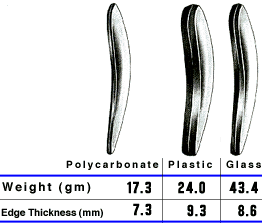
Multifocal Lenses
Most people over the age of forty gradually lose their ability to focus at all distances. This is a natural condition known as presbyopia. There are plenty of options available to deal with the onset of presbyopia. Reading glasses are one solution but they can be annoying when you want to see in the distance and you have to peer over the top or remove them all together. Bifocals are another alternative.
Bifocal Lenses
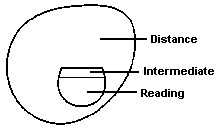 |
Flat Top
or Straight Top: This type of bifocal is available in widths of 25mm, 28mm, 35mm, 40mm & 45mm. This lens corrects both distance and near vision. |
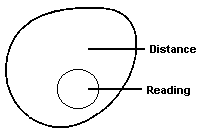 |
Round Seg
(Kryptok): Though the popularity of this lens has decreased since the arrival of the flat-top, the round seg remains a useful alternative for those who require a small reading area designed for specific tasks; (ie. golfers, electricians, pilots, and plumbers). |
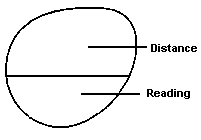 |
Executive
(Franklin): This lens offers the widest reading area but its design creates a thick and heavy lens. |
Trifocal Lenses
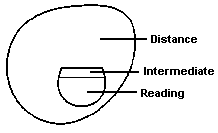 |
Flat-Top: This is the most common of the lined trifocals. They come in sizes 7x25, 7x28, 8x35, and 14x35. The first number represents the height of the top half whereas the second number represents the width of the segment at its widest point. The most common is the 7x28. |
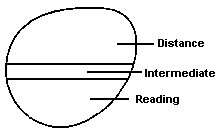 |
Executive:
This lens provides a very large reading and intermediate area, but the increased weight of its design may be uncomfortable for most wearers. |
Progressive Lenses
 Progressive
(Invisible):
Progressive
(Invisible):
Progressive MultiFocal lenses are designed to satisfy the widest possible range of visual needs without unflattering dividing lines. You can use the same glasses for close work, mid-range and long distance vision – providing natural vision at all distances. The advantage of a progressive lens is that the segments are invisible, and the transition from distance to near vision is gradual.
Lens Enhancements
Anti-Reflective Coating
With anti-reflective coating application, lenses appear invisible, allowing people to see your eyes behind your glasses. This coating allows for maximum reduction of reflection and glare, and is especially helpful for night-driving.
Tints
By reducing glare and the amount of visible light that enters your eyes, tints may add to your eyewear comfort. Adding a subtle tint to your everyday lenses may also complement your facial tones, adding a more fashionable look to your new glasses.
How tints are applied: Tints are applied to plastic lens materials through a process of absorption. The lenses are immersed into a warm color bath, and depending on the length of time they sit in the tank, emerge in varying shades of darkness. A lens that requires only a light tint will go into the bath for just a few minutes, while a lens that is meant to be sunglass-dark will stay in for quite some time.
Glass lenses are either manufactured with the color distributed throughout the lens material, or a tint is applied as a coating in a vacuum chamber after fabrication.
· Yellow, brown, and amber tints help improve depth perception. Sometimes referred to as a "blue-blocker" because the color keeps blue light from entering the lens; it is often the color of choice for target shooters because it decreases haze and makes objects appear sharper, with more contrast.
· Rose or pink tints are excellent for people who work under fluorescent lighting.
Ultraviolet Coating
Ultraviolet light is invisible to the human eye. It is commonly divided into two types: UV-A and UV-B. Guarding against both types of UV light is the best course of action.
UV-A light is less intense than UV-B. However, UV-A penetrates deeper into the eye than UV-B.
UV-B light causes sunburn of the skin and can damage the cornea and lens of the eye.
Photochromatic Lenses
Photo chromatic lenses contain millions of light-sensitive photocromic molecules. When exposed to sunlight's UV rays, a chemical reaction quickly transforms these molecules into colored light absorbers. Ultraviolet (UV) light from the sun causes the lenses to change from virtually clear indoors to dark outdoors.
Tips On Caring for Your Eyeglasses
· Keep your lenses clean by washing them twice daily in warm water or with special lens cleaner. Dry them with a soft cotton towel or special eyeglass cleaning cloth. Don't wipe your lenses while they are dry. Wash or blow off dust or grit instead. Never use paper or silicone products to wipe glasses as they can scratch the lens.
· When not wearing your glasses, keep them in their protective case. Never rest them face down on their lenses.
· Always put on or take off your glasses with both hands, grabbing the temples midway on each side and sliding them backwards over your ears. This will help them keep their adjustment longer.
· Avoid spraying aerosol hairsprays and perfumes near your lenses; these products may contain acetones and other chemicals which can cause lens coatings to peel.